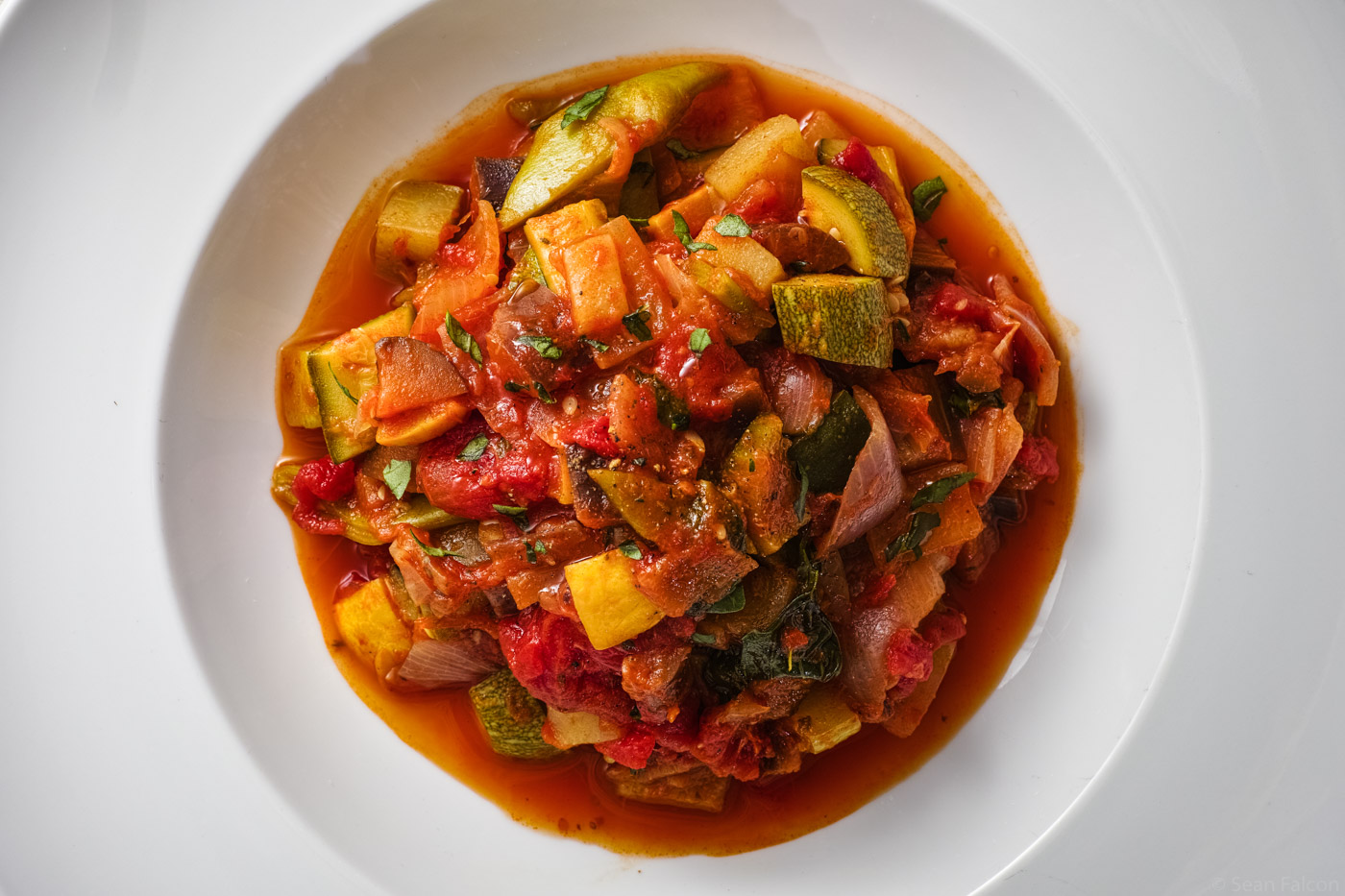Ciambotta

This dish is very easy to cook, so most of the time you’ll spend on it is the prepping. If you can’t find some of these ingredients, feel free to swap it for another vegetable. Since everything is stewed, you don’t have to spend a lot of time on fancy cuts. Just give everything a rough chop so that each piece is small enough to fit on a fork. Make sure you cut everything to the same size pieces so they all cook at the same speed. This dish will be cooked over medium heat the entire time. The slower method of cooking allows the vegetables to develop a rich flavor so make sure things stay at a simmer and not a boil.
This has become my go-to dish for many, many reasons:
It’s incredibly easy to make and it’s relatively quick to prep.
It’s a great way to use vegetables from the garden if you have one
All of the ingredients are cheap
It can be made in small batches for one meal or in a larger batch for the week.
It can be eaten as-is or turned into many other dishes.
It tastes better the next day after the flavors have matured.
It’s healthy. Tomatoes improve their delivery of nutrients, such as lycopene, during the cooking process.
This dish is best in the spring when all of these are in season. especially tomatoes and squash. can be done any time of the year. use good canned tomatoes if fresh ones are out of season.
This dish goes exceptionally well with chicken. Especially if it has a bit of char to it from the grill.
It goes great with white fish.
It can be tossed with pasta.
It can go on top of brown rice or mix it up like a jambalaya.
It’s vegan.
It doesn’t have to be vegan.
You don’t need a lot of salt since slowly cooking the vegetables develops strong flavors that are later complemented by the acids.
It can be made spicy.
It’s easy to add your own spin to it with different vegetables and seasoning.
Needs very little oil, if any.
Very forgiving, so you can easily swap out vegetables that aren’t available.
Can be pureed into a smooth sauce if desired.
Ingredients
1 zucchini
1 Crookneck or Golden rod squash
2 Cousa squash
1 Chayote squash
1 Chinese eggplant
1 handful of long romano beans
1 sweet red Italian onion (or just red onion)
1 yellow onion
1 bell pepper
6-10 cloves of garlic, smashed
1 can San Marzano whole tomatoes, roughly chopped and sauce from the can reserved (fresh tomatoes can be used if they’re in season)
1tbsp fresh squeezed lemon juice
1tbsp champagne vinegar (or to taste)
1/2 tbsp white wine vinegar to taste
crushed red pepper flakes
1tbsp + 1tsp dried oregano
onion powder
dash of cumin
2 bay leaves
fresh basil (or thyme)
kosher salt (4g or to taste)
fresh ground black pepper
canola oil
Prep
Wash all of your produce
Squashes: trim the top and bottom ends off.
Eggplant: trim the top off
Canned Whole Tomatoes: Separate the tomatoes from their liquid. Rough chop whole tomatoes. Reserve both liquid and chopped tomatoes.
Rough chop all of the vegetables. They don’t have to be neat, but they should be able to fit on a fork with room for others. Try to keep the cuts about 1” or less.
Cooking Instructions
Add a tablespoon of cooking oil to the pan over medium heat
As the oil begins to shimmer, add your chopped onions to the pan and sauté them for 2 minutes or until they just begin to become translucent.
Add the rest of the veg to the pan, saving the tomatoes for last.
Pour in the sauce from the tomato can first, give it a stir to combine and then add the chopped tomatoes.
Add the salt, oregano, bay leaves, pepper and any other seasonings you’d like.
Cover with a lid and cook over medium heat for 25 minutes.
Remove the lid and test some of the squash for tenderness. They should be completely tender with no resistance when pierced with a knife or when chewed.
Give the pot a stir a few times during the cooking process to make sure nothing is sticking to the bottom of the pan.
They’ll probably need another 10-15 minutes or so to finish cooking, so at this point you can leave the lid off. This will help evaporate some of the liquid in the pan, which will give the dish a stronger flavor as it reduces down. The more they cook, the more intense their flavors will become. If the vegetables are cooked through at this point, then consider it done.
If they’re not cooked enough, you can add a 1/4 cup of water if the pan begins to dry out before the vegetables are cooked through.
Once everything is cooked, taste a spoonful of everything together and adjust your seasonings.
Add your vinegar and lemon juice at this point. You can use the vinegar to offset the amount of salt you’re using for a lower sodium dish that still has a lot of good flavor.



